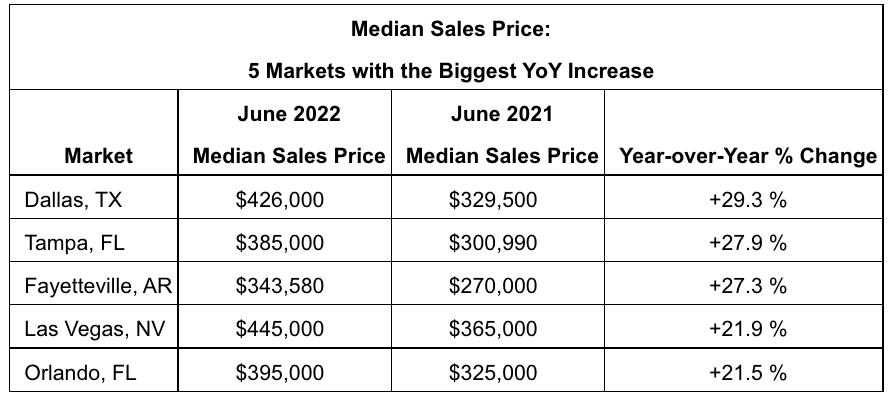AZ Big Media Phoenix leads nation in new listings as housing market balances
Halfway through the peak summer buying season, this year’s home sales are falling short of 2021’s, as signs of more balance in the market take hold, according to the latest RE/MAX National Housing Report. And leading the year-over-year new listings percentage increase was Phoenix, which was a clear No. 1 in the U.S.
• June posted the most home sales of any month thus far this year, topping May by 4.7% but falling 17.6% short of June 2021.
• Inventory grew for a third consecutive month by a whopping 34.1% over May and 27.5% year over year.
• While up 11% year over year, the Median Sales Price of $428,000 inched just 0.6% above May’s.
READ ALSO: Arizona No. 2 for largest house price appreciation
Bolstering the inventory was a 7.7% increase in new listings month over month, which was an increase of 1.6% over June 2021. Months Supply of Inventory jumped from 0.9 in May to 1.4 in June. A year ago, Months Supply of Inventory was 1.0.
“The market is moving toward greater balance, especially with inventory gains and the slowing of price appreciation. The past few years have been one of the most competitive times ever for buyers – and we’re finally seeing conditions ease up,” said Nick Bailey, President and CEO. “It’s due partly to the rise in interest rates – although buyers are also finding solutions in ARMs, FHA products and other financing – but even more significant is the increase in listings after several years of instant sales and low inventory. Markets like Nashville and Phoenix saw an increase in new listings of over 20 percent last month, bringing new options for buyers who may have sidelined themselves in the frenzy of last year.”
Added RE/MAX Professionals Sales Associate/Owner Nate Martinez, who is based in Phoenix, AZ, “The Phoenix metro area is in the process of a market shift from a red-hot market to more of a balanced market. With inventory increasing, we’re seeing more opportunities for buyers, a leveling of home prices and a reduction in homes selling with multiple offers.”
The average Close-to-List Price Ratio in June was 102%, meaning that homes, in general, sold for 2% more than the asking price. That dropped from 103% in May and matched June 2021. Homes spent an average of 25 days on the market in June.
Highlights and the local markets leading various metrics for June include:
New Listings
Of the 53 metro areas surveyed in June 2022, the number of newly listed homes is up 7.7% compared to May 2022, and up 1.6% compared to June 2021. Leading the year-over-year new listings percentage increase were Phoenix, AZ at +34.1%, Nashville, TN at +22.8%, and Philadelphia, PA at +21.8%. The markets with the biggest decrease in year-over-year new listings percentage were Kansas City, MO at -18.5%, Honolulu, HI at -15.9%, and Hartford, CT at -15.6%.
Closed Transactions
Of the 53 metro areas surveyed in June 2022, the overall number of home sales is up 4.7% compared to May 2022, and down 17.6% compared to June 2021. The markets with the biggest decrease in year-over-year sales percentage were Miami, FL at -35.1%, San Diego, CA at -33.1%, and Coeur d’Alene, ID at -32.2%. No metro area had a year-over-year sales percentage increase.

Median Sales Price – Median of 53 metro area prices
In June 2022, the median of all 53 metro area Sales Prices was $428,000, up 0.6% compared to May 2022 and up 11.0% from June 2021. Only one metro area saw a year-over-year decrease in Median Sales Price – Trenton, NJ at -1.2%. Thirty-nine metro areas increased year-over-year by double-digit percentages, led by Dallas, TX at +29.3%, Tampa, FL at +27.9%, and Fayetteville, AR at +27.3%.

Close-to-List Price Ratio – Average of 53 metro area prices
In June 2022, the average Close-to-List Price Ratio of all 53 metro areas in the report was 102%, down from 103% compared to May 2022, and flat compared to June 2021. The Close-to-List Price Ratio is calculated by the average value of the sales price divided by the list price for each transaction. When the number is above 100%, the home closed for more than the list price. If it’s less than 100%, the home sold for less than the list price. The metro areas with the lowest Close-to-List Price Ratio were Coeur d’Alene, ID and Miami, FL, which tied at 97%, followed by Bozeman, MT and New Orleans, LA, which tied at 99%. The highest Close-to-List Price Ratios were in San Francisco, CA at 109%, and Burlington, VT at 107%, followed by a five-way tie between Boston, MA, Richmond, VA, Manchester, NH, Hartford, CT, and Trenton, NJ at 105%.




